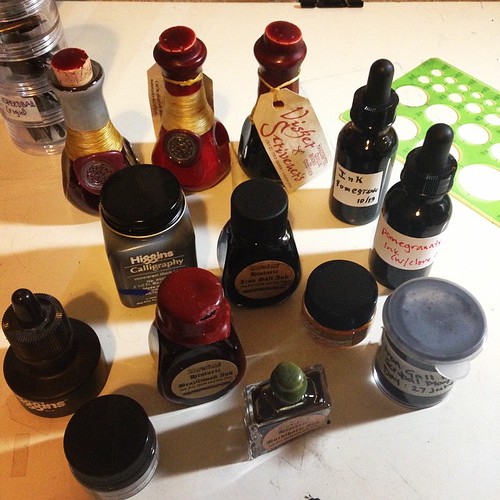As you may have noticed, I do some scribal stuff. A little bit of calligraphy and illumination. Sometimes. I may also have a ridiculous collection of inks. Remember these?
Yeah, there’s more now. I have a problem, really.
One of the companies I buy from is a very small organization called Scribal Workshop. I met Lucas, the owner, at his booth at Sherwood Renaissance Festival a couple years ago. He was dressed as a monk, with full tonsure and everything. We had a wonderful conversation about inks and pigments and illumination and I took one of his cards.
About a year later, Ansteorra hosted the Known World Heraldic and Scribal Symposium (KWHSS, for slightly tongue-tying short) in San Antonio. I knew that Lucas was local-ish, and I sent him an email saying he might consider merchanting there. It was a whole symposium full of his people! To my delight, he did and we also ended up forming a friendship along the way. I own several products of his: a lead plummet, four different kinds of ink, and six pigments.
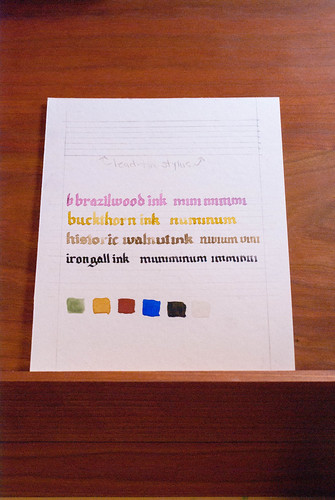 The plummet is basically a sharpened bit of lead-tin that makes pale pencil-like marks on paper and vellum. I use it for marking calligraphy guide lines and sketching out basic lines for painting. The plummet is made from one of Cenini’s recipes, and does contain lead. I am very careful about having it out around Poppet, and making sure I wash my hands thoroughly after using it.
The plummet is basically a sharpened bit of lead-tin that makes pale pencil-like marks on paper and vellum. I use it for marking calligraphy guide lines and sketching out basic lines for painting. The plummet is made from one of Cenini’s recipes, and does contain lead. I am very careful about having it out around Poppet, and making sure I wash my hands thoroughly after using it.
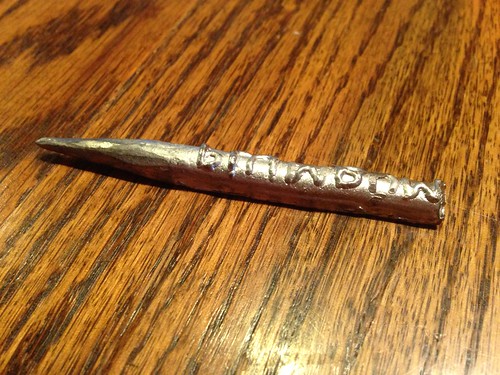
It’s not very big; about 3″ long, but isn’t as soft as a #2 pencil. It’ll last me a good while.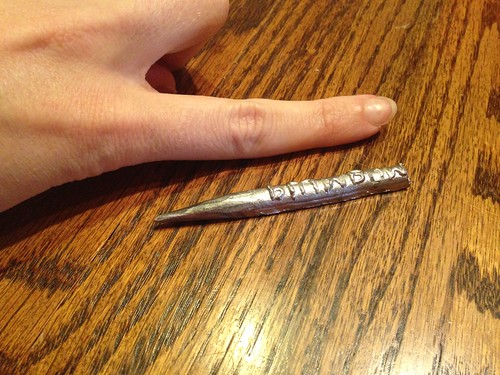 The guidelines there were made by the plummet. Next up are brazilwood and buckthorn inks. The brazilwood is a very beautiful pinkish-red translucent ink. It was used mainly for making ruling lines. I’ve found that I have to be careful how I use it. It needs a very clean nib or quill. Any iron gall residue will result in a darkening of the ink to a very pretty (but undesirable) purple color. The buckthorn ink is a translucent yellow-green ink with LOTS of chasing. It was used as an enhancer for green pigment, and later as a pigment itself.
The guidelines there were made by the plummet. Next up are brazilwood and buckthorn inks. The brazilwood is a very beautiful pinkish-red translucent ink. It was used mainly for making ruling lines. I’ve found that I have to be careful how I use it. It needs a very clean nib or quill. Any iron gall residue will result in a darkening of the ink to a very pretty (but undesirable) purple color. The buckthorn ink is a translucent yellow-green ink with LOTS of chasing. It was used as an enhancer for green pigment, and later as a pigment itself.
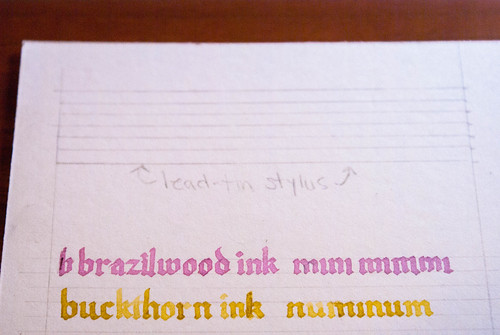
The walnut ink is from a slightly later-period recipe than the medieval inks; it’s a Colonial era recipe. It has a lot of shading as well, and a lovely brown color. The iron gall is what I use is most of my scroll work. It’s a violet shaded grey ink that turns black on the paper as it oxidizes. It’s hard to achieve an iron gall ink that will remain stable over a long period of time, but Lucas’ experience with chemistry means that his inks are all pH balanced and stable.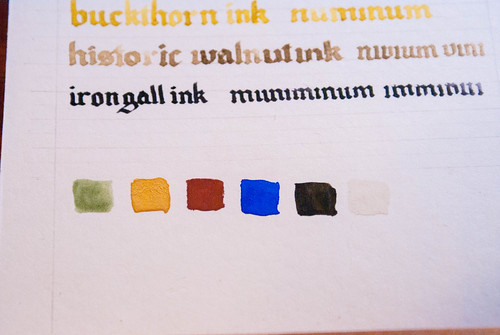 The six pigments I got from him came in seashells, just like a medieval palette. They come in basic earth colors, sap green (incidentally, from the same buckthorn berries as the ink), yellow and red ochres, cerulean blue, black and white. The sap green is really only good for shading, as no matter how thick I paint it, it remains transparent, But the rest can be treated the same way as modern gouache.
The six pigments I got from him came in seashells, just like a medieval palette. They come in basic earth colors, sap green (incidentally, from the same buckthorn berries as the ink), yellow and red ochres, cerulean blue, black and white. The sap green is really only good for shading, as no matter how thick I paint it, it remains transparent, But the rest can be treated the same way as modern gouache.
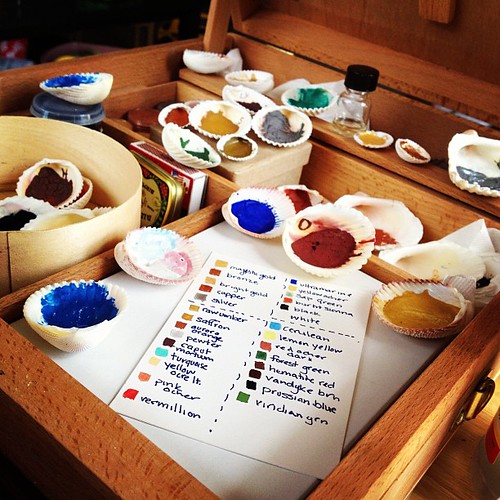 Lucas also offers other scribal items as well: wax tablets with wooden or metal styli, scribes’ pen-knives, pre-cut quills, and paper scrolls on his Etsy shop.
Lucas also offers other scribal items as well: wax tablets with wooden or metal styli, scribes’ pen-knives, pre-cut quills, and paper scrolls on his Etsy shop.

